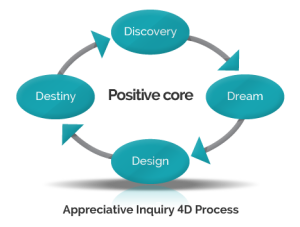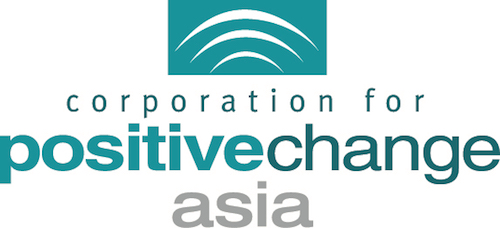Adapted from The Power of Appreciative Inquiry, 2nd Edition
Diana Whitney and Amanda Trosten-Bloom
Strategic Focus: Our work begins with a compelling strategic focus or change agenda – something of significance that a client organization or community hopes to realize. For example: transformation of leadership style, the alignment of strategy and culture, or employee satisfaction.
The process we use to achieve the Strategic Focus and generate positive results is the Appreciative Inquiry 4-D Process. It enables us to direct the attention and dialogue of an organization on its most powerful potential – its positive core. The positive core is the essential nature of the organization at its best – people’s collective wisdom about the organization’s tangible and intangible strengths, capabilities, resources, potentials and assets. The Appreciative Inquiry 4-D Process unleashes the energy and ideals of the positive core for transformation and sustainable success.
 Affirmative Topic Choice: The 4-D Process begins with the thoughtful identification of what is to be studied – affirmative topics. Since human systems move in the direction of what they study, the choice of what to study – what to focus organizational attention on – is both essential and strategic. The topics that are selected provide a framework for collecting stories, discovering and sharing best practices, and creating a knowledge-rich work environment. They become the organization’s agenda for learning and innovation.
Affirmative Topic Choice: The 4-D Process begins with the thoughtful identification of what is to be studied – affirmative topics. Since human systems move in the direction of what they study, the choice of what to study – what to focus organizational attention on – is both essential and strategic. The topics that are selected provide a framework for collecting stories, discovering and sharing best practices, and creating a knowledge-rich work environment. They become the organization’s agenda for learning and innovation.
Once selected, affirmative topics such as “inspired leadership,” “optimal margins,” or “culture as competitive advantage” guide the 4-D Process of Discovery, Dream, Design and Destiny.
Discovery: The Discovery phase is a diligent and extensive search to understand the “best of what is” and “what has been.” It begins with the collaborative act of crafting appreciative interview questions and constructing an appreciative interview guide. Appreciative Inquiry questions are written as affirmative probes into an organization’s positive core, in the topic areas selected. They are written to generate stories, to enrich the images and inner dialogue within the organization, and to bring the positive core more fully into focus.
The results of Discovery include:
- The formation of new relationships and alliances, that bridge across traditional barriers.
- A rich description or mapping of the organization’s positive core.
- Organization-wide sharing and learning from stories of best practices, golden innovations and exemplary actions.
- Greatly enhanced organizational knowledge and collective wisdom.
Dream: The Dream phase is an energizing exploration of “what might be”: a time for people to explore their hopes and dreams for their work, their working relationships, their organization, and the world at large. It is a time for groups of people to engage in thinking big, thinking out of the box, and thinking out of the boundaries of what has been successful and meaningful in the past.
The intent of the Dream phase is to identify and spread generative, hopeful images of the future. Typically this is accomplished in large group forums, where groups of stakeholders explore:
- The organization’s most creative positive potentials,
- Bold and compelling visions,
- Strategic opportunities for the future,
- An elevated sense of purpose.
Design: We live in a designed world, a world created by human thought, words and interactions. Language is the human design tool; dialogue the process. The Design phase involves making choices about “what should be” within an organization or community. It is a conscious re-invention or co-creation of the strategies, structures, culture, processes and systems needed to achieve the organization’s or community’s highest ideals.
In each Appreciative Inquiry the question of what are we designing is essential and must be answered in reference to the Strategic Focus. For example: if the strategic focus of the process is culture transformation, then the design phase calls for the design of a vision and principles for the new culture. If the strategic focus is community development then the design phase result in a set of propositions describing the ideal community. During Design an organization’s or community’s positive core of strengths, and its hopes and dreams for the future are aligned, integrated and embedded into a set of design propositions or principles. They in turn become the blueprint for its destiny.
Destiny: The Destiny phase initiates a series of inspired actions that support ongoing learning and innovation – or “what will be.” Since the entire 4-D Process provides an open forum for employees to contribute and step forward in the service of the organization, change occurs in all phases of an Appreciative Inquiry process. The Destiny phase, however, focuses specifically on personal and organizational commitments and paths forward. The result of destiny is generally the launch of innovation teams throughout the organization.
